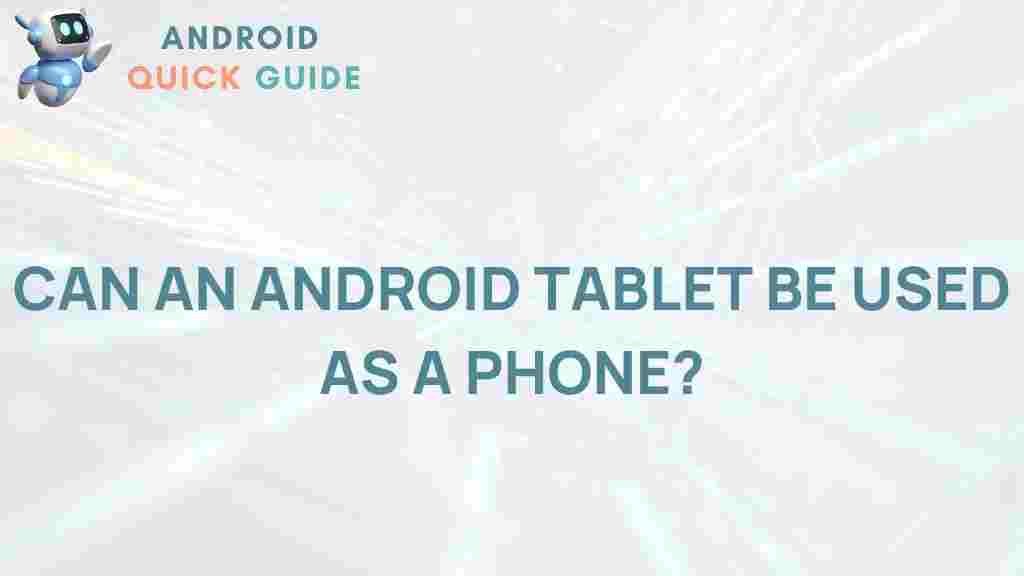Unlocking the Potential: Using an Android Tablet as a Phone
In today’s digital age, smartphones and tablets have transformed the way we communicate and interact with technology. Among these devices, the Android tablet stands out for its versatility. While primarily designed for entertainment, browsing, and productivity, many users may not realize that an Android tablet can also function as a phone. This article explores how to unlock this potential, providing you with a detailed guide on making and receiving calls using your Android tablet, troubleshooting common issues, and tips for optimizing your experience.
Understanding the Basics
Before diving into the specifics, it’s essential to understand what an Android tablet is. An Android tablet is a mobile device that runs on the Android operating system. Unlike traditional laptops or desktops, tablets are designed for portability and touch interaction, making them ideal for casual use. They come in various sizes and specifications, allowing users to choose one that fits their needs.
Why Use an Android Tablet as a Phone?
- Cost-Effective: If you already own an Android tablet, using it as a phone can save you money on purchasing a separate device.
- Large Display: The larger screen of a tablet can enhance the calling experience, especially for video calls.
- Multifunctionality: Tablets offer various applications and features, allowing for an all-in-one device for communication, entertainment, and productivity.
How to Use Your Android Tablet as a Phone
Using your Android tablet as a phone involves several steps. Below is a comprehensive guide to help you set it up:
Step 1: Ensure Your Tablet Supports Cellular Connectivity
First, check if your Android tablet has cellular capabilities. Some tablets come with built-in SIM card slots, allowing them to connect to mobile networks. If your tablet does not have cellular capability, you can still use Wi-Fi calling.
Step 2: Obtain a SIM Card
If your tablet supports cellular connectivity, you will need a SIM card. You can get a SIM card from your mobile service provider. Ensure that the plan you choose allows for voice calling.
Step 3: Insert the SIM Card
Once you have your SIM card, insert it into your tablet:
- Power off your tablet.
- Locate the SIM card slot, usually found on the side of the device.
- Insert the SIM card into the slot.
- Power on your tablet.
Step 4: Configure Your Tablet for Calls
After inserting the SIM card, you may need to configure your tablet to make and receive calls. Follow these steps:
- Go to Settings.
- Select Network & Internet.
- Tap on Mobile Network.
- Enable the Mobile Data option.
- Check that Voice over LTE (VoLTE) is enabled for better call quality.
Step 5: Download a Calling App
If your tablet does not have a native phone app, you can download a third-party calling app from the Google Play Store. Some popular options include:
- Google Voice: Allows you to make calls and send texts using your existing phone number.
- Skype: Great for making voice and video calls over the internet.
- WhatsApp: Offers voice and video calling to other WhatsApp users.
Step 6: Making and Receiving Calls
Once everything is set up, you can start making and receiving calls:
- Open your calling app.
- Dial the number you wish to call or select a contact from your list.
- To receive calls, ensure your tablet is connected to the cellular network.
Troubleshooting Common Issues
While using your Android tablet as a phone can be convenient, you may encounter some issues. Here are some common problems and their solutions:
Problem 1: Unable to Make Calls
- Check Network Connection: Ensure you have a strong cellular or Wi-Fi connection.
- Restart Your Tablet: Sometimes, a simple restart can resolve connectivity issues.
- Verify SIM Card: Ensure the SIM card is correctly inserted and activated.
Problem 2: Poor Call Quality
- Check VoLTE Settings: Make sure VoLTE is enabled in your network settings.
- Reduce Background Noise: Move to a quieter area if you’re experiencing static or interference.
- Update Apps: Ensure your calling app is up to date for optimal performance.
Problem 3: Battery Draining Quickly
- Disable Unused Features: Turn off features like Bluetooth and location services when not in use.
- Optimize Settings: Use battery saver mode available in your Android settings.
Enhancing Your Experience
To get the most out of your Android tablet as a phone, consider these tips:
- Use Headphones: Using wired or Bluetooth headphones can improve call quality and provide privacy.
- Sync Contacts: Sync your contacts with your Google account for easy access and management.
- Regular Updates: Keep your tablet’s software and apps updated to avoid security vulnerabilities.
Conclusion
Using an Android tablet as a phone can be a game-changer for many users, providing convenience and multifunctionality. Whether you are looking to save money or simply prefer a larger screen for calls, the process is relatively straightforward. By following the steps outlined in this article and troubleshooting common issues, you can easily unlock the full potential of your Android tablet.
For further information on optimizing your mobile devices, check out this helpful resource: Mobile Device Management Tips.
Embrace the versatility of your Android tablet and transform it into a powerful communication tool today!
For more insights and guides, feel free to explore our other articles: Explore More Guides.
This article is in the category Guides & Tutorials and created by AndroidQuickGuide Team
